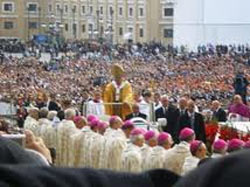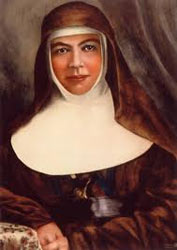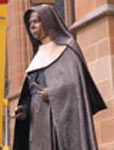Monday August 8 marks the 102st anniversary of the death of Mary MacKillop and the first Feast Day of Australia’s first Saint.
Canonised by Pope Benedict XVI on 17 October 2010, Saint Mary of the Cross MacKillop’s Feast Day will be celebrated not only at schools, parishes and churches across Australia but by communities and individuals worldwide.
Although her death occurred more than a century ago, she continues to inspire men, women and children whether Catholic or non-Catholic.
Her Feast Day, which was declared a Solemnity by the Vatican at the request of the Australian Catholic Bishops Conference earlier this year, is also a time to contemplate her remarkable life, her sense of social justice and her enormous contribution to education and as a champion of the poor, vulnerable and marginalised.
But while most Australians know Mary MacKillop’s name, many are unaware of exactly what this compassionate, devout and determined young woman achieved in her lifetime or why she remains such an inspiration, not only to Australians but to men and women worldwide.
The co-founder of the Josephites, the Sisters of St Joseph of the Sacred Heart, she was a tireless advocate of education and schools. At just 24 she established a school for children of the poor and underprivileged in Penola, SA, and under her guidance, her Order went on to found schools not only across SA but also in Victoria, NSW and eventually New Zealand.

St Mary and her Sisters were also responsible for setting up orphanages and homes for the destitute as well as establishing refuges for ex-inmates of Australia’s grim nineteenth century prisons. She also set up shelters for former prostitutes earning criticism and outrage from the city fathers who believed giving aid to prostitutes, reformed or otherwise, was beyond the pale.
In a world of strait-laced Victorians as well as a male-dominated Church, St Mary’s unwavering commitment to those on the margins of society constantly met with opposition. Antagonism to what she was trying to achieve came not only from the general public but from many of Australia’s Irish-born Bishops. But with her strength of faith in God and her vision of a better world for all, St Mary refused to be daunted. With patience, a forgiving heart and trust in God, she managed to overcome whatever obstacles were put her way.
Born in Brunswick Street, Fitzroy in Melbourne in1842, St Mary was the eldest of eight children, the daughter of Scottish-born immigrants Alexander and Flora MacKillop. The son of prosperous parents, Alexander had studied for the priesthood in Rome but due to ill health had been unable to continue with his studies. Returning to Scotland he sailed for Australia with his parents. In Melbourne he met and married fellow Scot, Flora McDonald but unlike his father, Alexander was financially inept and his family was often without a home and had to frequently rely on the generosity of friends and relatives.
Well-schooled himself, St Mary’s father was a strong believer in education and when Mary’s education at private schools had to be abandoned when he lost all his savings in a failed business venture, he took over as her teacher and chief educator.
A brilliant horsewoman and teacher
From an early age, St Mary was the mainstay of the family. Kind, patient and mature beyond her years, she had an instinctive compassion and selflessness. At just four years of age, noticing her mother flagging with tiredness as they clambered up a hill, she offered her arm to assist her. At eight, St Mary was caring for five younger brothers and sisters who regarded her as their second mother, and by the time she was 10 she had taken over the care of Flora’s latest newborn when the nurse employed to help with the family turned out to be a drunk.
Joining the workforce at 16 to help with the upkeep of her large poverty-stricken family, St Mary quickly proved herself as a hard worker and her employees, Sands and Kenny (now Sands & MacDougall), a printing and stationary company, paid her a forewoman’s salary and gave her considerable responsibility and trust.
A year or two later, offered the job of governess to young cousins at her Uncle Cameron’s extensive property at Penola in South Australia, teenage St Mary showed her aptitude not only as a teacher but as a horsewoman. Having inherited her mother’s skills with horses, she could handle virtually any mount, no matter how frisky, and frequently helped out with the cattle roundups.

In Penola, Mary took a young Aboriginal child under her wing. The little girl’s father worked on the station and her mother had gone “walkabout.” Distressed at the girl’s neglected condition, Mary bathed and washed her, treated her sores, shampooed her hair and gave her religious instruction, convinced that everyone whatever their colour, religion or gender had a right to be accepted and valued, regardless of their position in society.
At 19, St Mary met Father Julian Tenison Woods, the priest assigned to St Joseph’s Church and the Penola Parish. A talented missionary, musician, writer, scientist and lecturer, Fr Julian and St Mary had similar ideas on education and their faith. When he told her he needed help with the religious education of children in the outback, she instantly volunteered. But with her family in Melbourne still dependent on her income, at the eleventh hour she reluctantly had to turn him down and stay on as governess to her uncle instead.
Nevertheless Fr Tenison Woods and St Mary remained on good terms and in 1866 these two enthusiastic educators founded the Sisters of St Joseph of the Sacred Heart.
Australia’s first Sisters of St Joseph School
With a mission to live in poverty and provide Catholic education to the children of the poor and needy as well as extending “an all-embracing charity” to the underprivileged and indigent, the Sisters of St Joseph was unlike any other order of the time, and was the first “Australian-made” congregation.
Unconstrained by normal convent strictures which were customary in Ireland and adopted by Church leaders in Australia, St Mary and the Sisters of St Joseph obtained Papal approval to move freely from diocese to diocese with St Mary rather than a Bishop of the local diocese in charge of the Sisters and their work.
As the fledgling Congregation’s first member and its Mother Superior, St Mary took a vow of poverty, and donning a simple brown habit opened her first school in a disused stable on March 19 1866 in Penola, SA.
News of what would later be known as the Woods MacKillop School, spread quickly and on hearing about St Mary’s work, other young women came forward becoming Sisters of St Joseph as well as teachers at the school.
Within 12 months, the work of the Sisters of St Joseph had become so well known the newly-arrived Bishop of Adelaide, Irish-born Bishop Laurence Sheil, who had appointed Fr Julian Tennison Woods as his Director General of Catholic Education, asked St Mary and her Sisters to open a school in Adelaide.
Over the next four years, St Mary and the Sisters established 35 schools across the State as well as an orphanage, a women’s refuge and a House of Providence for the homeless and abused.
But instead of being praised for her work, the Bishop and Church leaders in Adelaide were upset by St Mary’s independence and the fact she and her Congregation were not under their control.
Fiercely conservative, the Bishop and Church leaders also objected to the Josephites’ vow of poverty and practice of begging to fund their schools, shelters and orphanages.
Adelaide’s Bishop Excommunicates Mary
In an attempt to wrest control of the Sisters and bring St Mary to heel, Father Keating and others spread rumours that she was a drinker. It is believed Father Keating was about to be exposed by the Josephites as a pedophile. But before this could happen, Bishop Sheil urged on by Keating and others in the Diocese, had St Mary excommunicated and thrown out of the Church for alleged insubordination. He then attempted to disband the Sisters.
Devastated, 29-year-old St Mary prayed to God, convinced her trust and belief in the Lord would sort out this terrible turn of events. Forbidden to have contact with anyone in the Church, she was given shelter by a Jewish family and received help and support from South Australia’s Jesuit priests.

Throughout this time she never lost her deep faith and trust in God. This was not misplaced and within five months, Bishop Sheil realising his error, retracted his statements and St Mary’s membership of the Church restored.
Sheil died nine days later, but St Mary who harboured no grudges and never blamed the Bishop or Church for their actions either by word or in her writings, nevertheless decided to seek official sanction for the Congregation she had founded, and in 1873 travelled to Rome to seek Papal approval for the Sisters of St Mary of the Sacred Heart.
Pope Pius IX was impressed with St Mary’s intelligence and determination and the young woman used her time in Europe to travel widely studying educational methods before returning to Australia where under her direction, the Sisters expanded their work, establishing schools throughout New South Wales as well as New Zealand.
Elected Superior General of the Order in 1875, St Mary decided to leave South Australia for Sydney in 1883 where she established the Sisters of St Joseph’s Mother House at North Sydney. But it wasn’t until 1888, 22 years after she had founded the Order that official approval of finally given by Pope Leo XIII.
Travelling extensively throughout Australasia over the next decade, St Mary founded convents, charitable institutions and free schools for children in Queensland, NSW, Victoria and SA as well as New Zealand, at time when most families had to pay to educate their children and only the wealthy could afford to send their children to school.
Filled with affection and a deep love of children, St Mary radiated warmth and kindness matched with boundless energy. Charismatic, she literally could light up a room and she became an inspiration to almost everyone she met with her piety, humility and love of life.
But in 1901, aged 59, she suffered a stroke while visiting Rotorua in New Zealand. Although she retained her mental acuity and vitality, she was now an invalid. Returning to Australia, she spent the remaining years of her life in Sydney.
“I have assisted at the deathbed of a saint.”
Shortly before her death, she was visited by the Archbishop of Sydney, Cardinal Patrick Moran who said on leaving the Mother House of the Sisters of St Joseph: “I consider this day to have assisted at the deathbed of a saint.”
St Mary died on Sunday August 8, 1909. Her funeral was held at St Mary’s Catholic Church on Miller Street, North Sydney and attended by an enormous crowd. Four years later in 1913, the Mary MacKillop Memorial Chapel was built and now houses her tomb. It was here that Pope John Paul II prayed on his visit to Australia in 1995 shortly after announcing her Beatification setting her on the path towards Sainthood.
On his visit to Sydney in 2008, Pope Benedict XVI also visited the Tomb in the tiny historic chapel at MacKillop Place and described the selfless determined Australian as “one of the most outstanding figures” in the nation’s history, praising her for her perseverance in the face of adversity and for her pleas for justice on behalf of the unfairly treated.
“She was a practical example of holiness.”
To be canonised, two miracles must be investigated and confirmed by the Vatican.
The first miracle, confirmed by the Church for Beatification, occurred in the 1960s when a woman with leukaemia was given only a few months to live. However when she asked the Sisters of St Joseph to pray to Mary MacKillop on her behalf and given a relic to wear, against all odds recovered from what had been diagnosed as an aggressive and fatal condition.
The second miracle, officially approved by the Vatican in late 2009, concerned a Hunter Valley woman with inoperable lung cancer and secondaries to the liver. Sent home to die, her family prayed to Mary MacKillop and not only did the woman recover but when she saw her doctors all traces of her tumours and the cancer had gone.
Today the Sisters of St Joseph can be found in all parts of the world working with the poor and in education, not just across Australia and New Zealand but in such far flung nations as East Timor, Peru, Canada, Scotland, Brazil and overseeing refugee camps in Uganda and Thailand.
To find out more about the work of the Sisters of St Joseph, and to download the liturgy specially written for the Feast Day of St Mary of the Cross MacKillop log on to www.sosj.org.au
